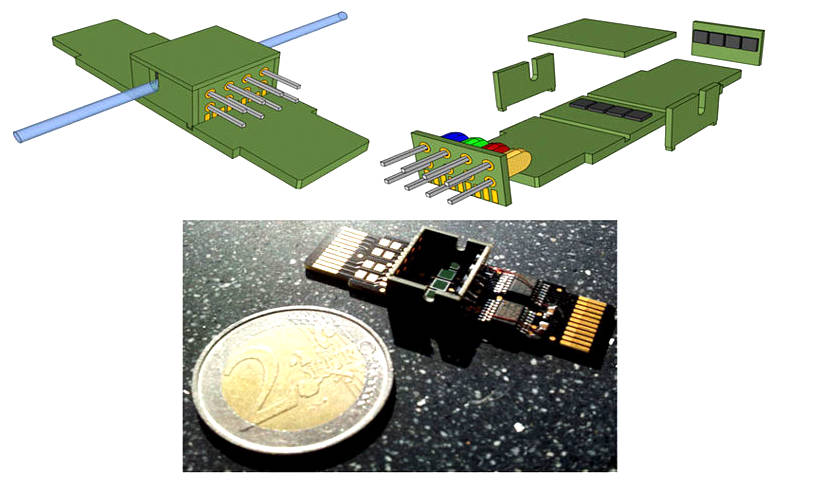Schematic structure and demonstrator of the optoelectronic absorption and fluorescence sensor
When ecosystems are stressed by the release of chemical substances, the effect of the various possible combinations on living organisms is still largely unknown. While the toxicological effect of individual substances is usually quickly recognized, the number of possible mutual influences increases sharply with the number of substances. The project “Optoflutronics” as part of the ongoing BMBF joint project “Competence Triangle Optical Microsystems 2020” (OptiMi2) aims at the efficient investigation of the combination effect of potential active and harmful substances. An efficient analysis of the toxicological parameter space can only be realized by consequent application of system integration in the sense of a combination of microfluidics, microoptics and microelectronics.
In this context, the CiS Research Institute leads the development of a micro-fluorescence sensor. In a multi-channel sensor, optical excitation with different wavelengths of light and measurement of transmission and fluorescence signals take place. The sensor is based on the combination of narrow-band high-efficiency light-emitting diodes, optical interference edge filters, micro-precision optics and highly sensitive photodetectors. The sensor is designed to detect a wide variety of fluorescent and absorbing substances in segments as small as a few nanoliters, which pass through the sensor at speeds of several centimeters per second within a fluidic channel.
The highly sensitive measurement requires sampling rates of several kilohertz and signal amplification directly on the sensor.
Partners:
TU Ilmenau, Institute for Micro- and Nanotechnologies MacroNano®.
MLU Halle-Wittenberg, Institute for Toxicology
CiS Research Institute for Microsensorics and Photovoltaics GmbH, Erfurt, Germany.
Please visit us at the COMPAMED 2012 trade show,
IVAM Product Market “High tech for Medical Devices” in hall 8a, booth no.: G 19.5.




